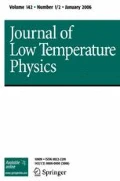Abstract
We study an Ising-like dynamic Hubbard (IDHB) model using dynamical mean field theory with an embedding potential. The prominent characteristic of the IDHB model is the broken electron–hole symmetry. Our calculations indicate that the electron–hole asymmetry enhances electron expulsion toward the surface of a semi-infinite bulk. Since correlated hopping amplitude produces the electron–hole asymmetry, it strongly affects the electron expulsion toward the surface.






Similar content being viewed by others
References
J.E. Hirsch, Dynamic Hubbard model. Phys. Rev. Lett. 87, 206402–4 (2001)
J.E. Hirsch, Why holes are not like electrons: a microscopic analysis of the differences between holes and electrons in condensed matter. Phys. Rev. B 65, 184502–184520 (2002)
J.E. Hirsch, Dynamic Hubbard model for solid with hydrogen-like atoms. Phys. Rev. B 90, 104501–104509 (2014)
J.E. Hirsch, Quantum Monte Carlo and exact diagonalization study of a dynamic Hubbard model. Phys. Rev. B 65, 214510–214516 (2002)
J.E. Hirsch, F. Marsiglio, Superconducting state in an oxygen hole metal. Phys. Rev. B 39, 11515–11525 (1989)
J.E. Hirsch, F. Marsiglio, Hole superconductivity: review and some new results. Phys. C 162–164, 591 (1989)
J.E. Hirsch, The origin of the Meissner effect in new and old superconductor. Phys. Scr. 85, 035704 (2012)
J.E. Hirsch, The London moment: what a rotating superconductor reveals about superconductivity. Phys. Scr. 89, 015806–015810 (2014)
J.E. Hirsch, Charge expulsion, charge inhomogeneity and phase separation in dynamic Hubbard models. Phys. Rev. B 87, 184506–184512 (2013)
H. Ishida, A. Liebsch, Embedding approach for dynamical mean field theory of strongly correlated heterostructures. Phys. Rev. B 79, 045130–045138 (2009)
R. Nourafkan, F. Marsiglio, M. Capone, Metallic surface of a bipolaronic insulator. Phys. Rev. B 82, 115127–115136 (2010)
R. Nourafkan, F. Marsiglio, Competition between reduced delocalization and charge transfer effects for a two-band Hubbard model. Phys. Rev. B 84, 075133–075135 (2011)
M. Potthoff, W. Nolting, Surface metal-insulator transition in the Hubbard model. Phys. Rev. B 59, 2549–2555 (1999)
M. Potthoff, W. Nolting, Metallic surface of a Mott insulator-Mott insulating surface of a metal. Phys. Rev. B 60, 7834–7849 (1999)
S. Schwieger, M. Potthoff, W. Nolting, Correlation and surface effect in vanadium oxides. Phys. Rev. B 67, 165408–165417 (2003)
J.K. Freericks, Dynamical mean field theory for strongly correlated inhomogeneous multilayered nanostructures. Phys. Rev. B 70, 195342–195414 (2004)
G.H. Bach, J.E. Hirsch, F. Marsiglio, Two-site dynamical mean field theory for the dynamic Hubbard model. Phys. Rev. B 82, 155122–155213 (2010)
G. Georges, G. Kotliar, K. Krauth, M.J. Rozenberg, Dynamical mean field theory of strongly correlated fermion systems and the limit of infinite dimensions. Rev. Mod. Phys. 68, 13 (1996)
D. Kalkstein, P. Soven, A Green’s function theory of surface states. Surf. Sci. 26, 85 (1971)
B. Giang, Dynamical mean field theory for the dynamic Hubbard model, Ph.D. thesis, chapter 6, 2011
J.E. Hirsch, Quasiparticle undressing in a dynamic Hubbard model: exact diagonalization study. Phys. Rev. B 66, 064507–064512 (2002)
R. Nourafkan, F. Marsiglio, Surface effects in doping a Mott insulator. Phys. Rev. B 83, 155116–155117 (2001)
M. Potthoff, W. Nolting, Metallic surface of a Mott insulator-Mott insulating surface of a metal. Phys. Rev. B 60, 7834–7849 (1999)
Acknowledgments
The author thank Dr. Reza Nourafkan and Dr. Frank Marsiglio for their useful advice. This work is funded by the Vietnam National Foundation for Science and Technology Development (NAFOSTED) under the Grant Number 103.02-2012.73
Author information
Authors and Affiliations
Corresponding author
Rights and permissions
About this article
Cite this article
Bach, G.H. Electron–Hole Asymmetry Driven Surface Charge Expulsion. J Low Temp Phys 181, 253–262 (2015). https://doi.org/10.1007/s10909-015-1342-6
Received:
Accepted:
Published:
Issue Date:
DOI: https://doi.org/10.1007/s10909-015-1342-6


